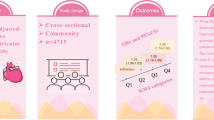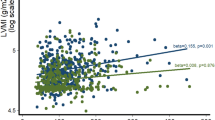Abstract
Some reports have suggested that white-coat hypertension (WCH) is associated with some features of the metabolic syndrome (MetS). These metabolic disturbances, instead of WCH per se, may potentially explain the greater extent of end-organ damage sometimes observed in WCH subjects (WCHs) when compared to normotensive individuals (NTs). The aim of the present cross-sectional study was to compare left ventricular (LV) structure and function in three groups of subjects: WCHs with MetS, WCHs without MetS and NTs. A total of 145 WCHs, 35% of whom had MetS, were enrolled. As controls, 35 NTs were also studied. In all subjects, routine blood chemistry, echocardiographic examination and 24-h ambulatory blood pressure monitoring were performed. When compared with WCHs without MetS, those with MetS showed higher LV mass indexed by height elevated by a power of 2.7 (LVMH2.7) (49.6±14.8 vs 38.9±9.8 g/m2.7; P<0.0001). The same parameter was greater in WCHs without MetS than in NTs (32±8 g/m2.7; P=0.004). Moreover, the E-wave deceleration time was longer in WCHs with MetS than in those without it (236.2±66.4 vs 200.5±30.8 ms; P<0.0001). The relationship of MetS with LVMH2.7 was confirmed in multivariate regression models. Our results seem to suggest that MetS may have a deleterious influence on LV structure and function in WCH. However, WCH, being associated with an increased LV mass, also in subjects without MetS, may not be considered as an innocuous phenomenon.
This is a preview of subscription content, access via your institution
Access options
Subscribe to this journal
Receive 12 digital issues and online access to articles
$119.00 per year
only $9.92 per issue
Buy this article
- Purchase on Springer Link
- Instant access to full article PDF
Prices may be subject to local taxes which are calculated during checkout

Similar content being viewed by others
References
Pickering TG, Coats A, Mallion JM, Mancia G, Verdecchia P . Task force V: white-coat hypertension. Blood Press Monit 1999; 4: 333–341.
Chung I, Lips GYH . White coat hypertension: not so benign after all? J Hum Hypertens 2003; 17: 807–809.
Palatini P, Mormino P, Santonastaso M, Mos L, Dal Follo M, Zanata G et al. Target-organ damage in stage I hypertensive subjects with white coat and sustained hypertension. Results from the HARVEST study. Hypertension 1998; 31: 57–63.
Sega R, Trocino G, Lanzarotti A, Carugo S, Cesana G, Schiavina R et al. Alterations of cardiac structure in patients with isolated office, ambulatory, or home hypertension. Data from the general population (Pressione Arteriose Monitorate E Loro Associazioni (PAMELA) Study). Circulation 2001; 104: 1385–1392.
Cerasola G, Cottone S, Nardi E, D'Ignoto G, Volpe V, Mulè G et al. White-coat hypertension and cardiovascular risk. J Cardiovasc Risk 1995; 2: 545–549.
Glen SK, Elliott HL, Curzio JL, Rees KR, Reid JL . White-coat hypertension as a cause of cardiovascular dysfunction. Lancet 1996; 348: 654–657.
Rizzo V, Cicconetti P, Bianchi A, Lorido A, Morelli S, Vetta F et al. White-coat hypertension and cardiac organ damage in elderly subjects. J Hum Hypertens 1996; 10: 293–298.
Manning G, Rushton L, Millar-Craig MW . Clinical implications of white coat hypertension: an ambulatory blood pressure monitoring study. J Hum Hypertens 1999; 12: 817–822.
Muldoon MF, Nazzaro P, Sutton-Tyrrell K, Manuck SB . White-coat hypertension and carotid artery atherosclerosis. A matching study. Arch Intern Med 2000; 160: 1507–1512.
Zakopoulos N, Papamichael C, Papaconstantinou H, Dubbins PA, Burrell CJ, Lekakis J et al. Isolated clinic hypertension is not an innocent phenomenon. Effect on the carotid artery structure. Am J Hypertens 1999; 12: 245–250.
Cavallini MC, Roman MJ, Pickering TG, Schwartz JE, Pini R, Devereux RB . Is white coat hypertension associated with arterial disease or left ventricular hypertrophy? Hypertension 1995; 26: 413–419.
Julius S, Mejia A, Jones K, Krause L, Schork N, Van de Ven C et al. ‘White coat’ versus ‘sustained’ borderline hypertension in Tecumseh, Michigan. Hypertension 1990; 16: 617–623.
Verdecchia P, Schillaci G, Borgioni C, Ciucci A, Porcellati C . White coat hypertension. Lancet 1996; 348: 1444–1445.
Khattar AS, Senior R, Lehiri A . Cardiovascular outcome in white-coat versus sustained mild hypertension: a 10-year follow-up study. Circulation 1998; 98: 1892–1897.
Strandberg TE, Salomaa V . White coat effect, blood pressure and mortality in men: prospective cohort study. Eur Heart J 2000; 21: 1714–1718.
Gustavsen PH, Hoegholm A, Bang LE, Kristensen KS . White coat hypertension is a cardiovascular risk factor: a 10-year follow-up study. J Hum Hypertens 2003; 17: 811–817.
Verdecchia P, Reboldi GP, Angeli F, Schillaci G, Schwartz JE, Pickering TG et al. Short- and long-term incidence of stroke in white-coat hypertension. Hypertension 2005; 45: 203–208.
Grundy SM, Cleeman JI, Daniels SR, Donato KA, Eckel RH, Franklin BA et al. Diagnosis and management of the metabolic syndrome. An American Heart Association/ National Heart, Lung, and Blood Institute scientific statement. Curr Opin Cardiol 2006; 21: 1–6.
Mule G, Nardi E, Cottone S, Cusimano P, Volpe V, Piazza G et al. Influence of metabolic syndrome on hypertension-related target organ damage. J Intern Med 2005; 257: 503–513.
Mule' G, Cerasola G . The metabolic syndrome and its relationship to hypertensive target organ damage. J Clin Hypertens (Greenwich) 2006; 8: 195–201.
Björklund K, Lind L, Vessby B, Andrén B, Lithell H . Different metabolic predictors of white-coat and sustained hypertension over a 20-year follow-up period. Circulation 2002; 106: 63–68.
Kario K, Pickering T . White-coat hypertension or white-coat hypertension syndrome: which is accompanied by target organ damage? Arch Intern Med 2000; 160: 3497–3498.
Pickering TG, Kario K . Comments on the study of Zakopoulos et al.. Am J Hypertens 1999; 12: 1158–1160.
Sahn DJ, DeMaria A, Kisslo J, Weiman A . The Committee on M-mode standardization of the American Society of Echocardiography. Circulation 1978; 58: 1072–1073.
Devereux RB, Alonso DR, Lutas EM, Gottlieb GJ, Campo E, Sachs I et al. Echocardiographic assessment of left ventricular hypertrophy: comparison to necropsy findings. Am J Cardiol 1986; 57: 450–458.
de Simone G, Devereux RB, Daniels SR, Koren MJ, Meyer RA, Laragh JH . Effect of growth on variability of left ventricular mass: assessment of allometric signals in adults and children and of their capacity to predict cardiovascular risk. J Am Coll Cardiol 1995; 25: 1056–1062.
Liao Y, Cooper RS, Durazo-Arvizu R, Mensah GA, Ghali GK . Prediction of mortality risk by different methods of indexation for left ventricular mass. J Am Coll Cardiol 1997; 29: 641–647.
de Simone G, Devereux RB, Roman MJ, Ganau A, Saba P, Aldermann MH et al. Assessment of left ventricular function by the midwall fractional shortening/end-systolic stress relation in human hypertension. J Am Coll Cardiol 1994; 23: 1444–1451.
Tunçkale A, Aran SN, Karpuz H, Dirican A . Relationship between insulin resistance and end-organ damage in white coat hypertension. Am J Hypertens 2004; 17: 1011–1016.
Julius S, Li Y, Brant D, Krause L, Buda A . Neurogenic pressor episodes fail to cause hypertension, but do induce cardiac hypertrophy. Hypertension 1989; 13: 422–429.
Acknowledgements
This work was supported in part by a grant from the Italian Ministry for University and Scientific Research (MURST). We express our gratitude to Mrs Concetta Truscello, Mr Giuseppe Patricolo and Mrs Rosa Anello for their nursing assistance.
Author information
Authors and Affiliations
Corresponding author
Rights and permissions
About this article
Cite this article
Mulè, G., Nardi, E., Cottone, S. et al. Metabolic syndrome in subjects with white-coat hypertension: impact on left ventricular structure and function. J Hum Hypertens 21, 854–860 (2007). https://doi.org/10.1038/sj.jhh.1002238
Received:
Revised:
Accepted:
Published:
Issue Date:
DOI: https://doi.org/10.1038/sj.jhh.1002238
Keywords
This article is cited by
-
Association of resistin and adiponectin with different clinical blood pressure phenotypes
Journal of Human Hypertension (2011)
-
Metabolic syndrome and biventricular hypertrophy in essential hypertension
Journal of Human Hypertension (2009)
-
Relationships between metabolic syndrome and left ventricular mass in hypertensive patients: does sex matter?
Journal of Human Hypertension (2008)



